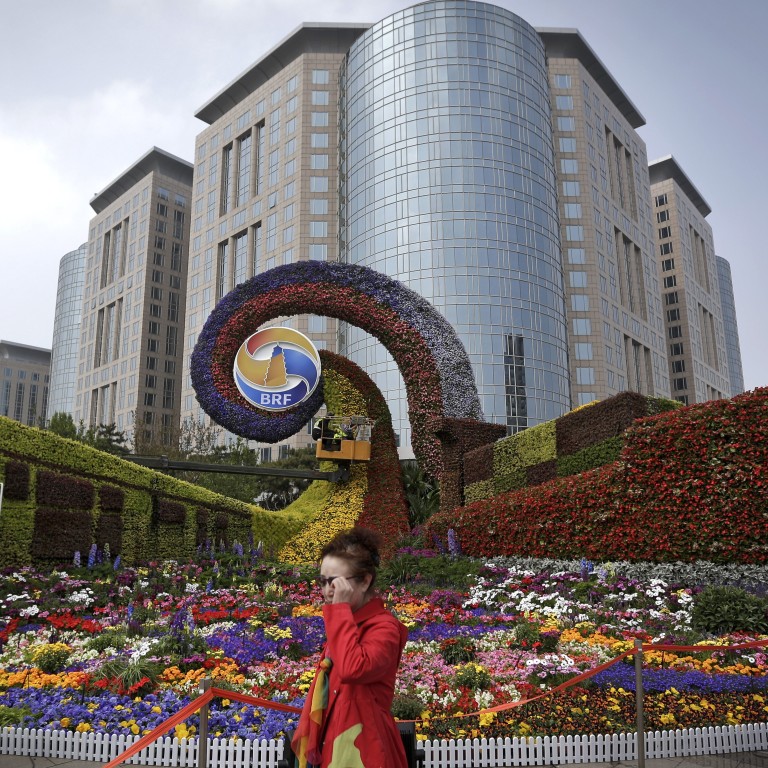
Belt and Road Forum: China tipped to counter critics with showcase projects
- Beijing might highlight successful schemes in response to claims that the grand plan is ill-defined, observers say
China is expected to showcase projects that it thinks can set the standard for its flagship “Belt and Road Initiative” and crack down on exploitation of the name as dozens of heads of state converge on Beijing this week to discuss the controversial grand infrastructure plan.
Since its launch by Chinese President Xi Jinping in 2013, the strategy has attracted criticism abroad for what some see as an attempt by Beijing to expand its influence by drawing countries into its economic and political orbit. Critics also say that some of the projects are “debt traps” and that the drive as a whole lacks transparency in both intention and financing.
On the eve of the three-day Belt and Road Forum, which starts on Thursday, a report compiled by the forum’s advisory council, a group of economists and former politicians with close ties to the Chinese government, highlighted ways Beijing could institutionalise the initiative, making it more like other international platforms.
The report identified areas to improve and “better brand” the initiative, and ways to expand financing sources for projects under the belt and road umbrella, including from international financing agencies.
But diplomatic observers said that one of the urgent tasks was to lay out a clear definition of the initiative by first restricting the use of the name.
China’s flexible belt and road approach leads to ambiguity
Since the initiative was launched, Chinese companies and local governments have been keen associate their projects the strategy, even if the projects have no link to infrastructure or international cooperation.
“Too many things are branding themselves in the category of belt and road, resulting in no one knowing what the belt and road is,” Wang Yiwei, a professor of international relations at Renmin University, said.
“This has generated a lot of confusion both at home and overseas. [In this forum] we need to clarify: what are the key projects, what are the major [trade] corridors ... these need to be crystal clear.”
That sentiment was reflected in a Chinese government notice two weeks ago that said some people had misused the initiative’s website for personal and commercial purposes, and this had had a negative impact on society.
Li Lifan, deputy director general of the Centre for Belt and Road Initiative Studies at the Shanghai Academy of Social Sciences, said use of “belt and road” was already being reined in among think tanks, with the authorities in Beijing rejecting a number of institutes’ applications to include the term in a name.
The initiative was launched as a way to promote economic cooperation and boost trade through infrastructure and trade from China to Europe, Africa and beyond. But uncertainty has dogged some of the projects, including a rail scheme that had to be renegotiated in Malaysia.
Sri Lanka rejects fears of China’s ‘debt-trap diplomacy’ in belt and road projects
Yu Hong, a National University of Singapore researcher specialising in the initiative, said China should clarify what constituted part of the initiative, when so many China-backed projects appeared to come under the umbrella.
“Now for many countries, they cannot distinguish what kind of projects actually belong to the Belt and Road Initiative, and what are private investment, property development and real estate, among others,” Yu said.
“I think for the long-term, if China really wants to sustain the belt and road development. It really needs to have, to make some distinction for which are so-called infrastructure projects under the belt and road, which are not.”
Observers said China was unlikely to offer a clear definition but would highlight some of the key elements of the existing projects. In a policy paper on Monday, the State Council’s Information Office highlighted several projects that were progressing, including an economic corridor connecting China, Mongolia and Russia.
Wang Huiyao, founder of the Centre for China and Globalisation, said he thought Beijing would use the forum showcase successful projects to set the standard for future schemes.
Diplomatic observers also expected a shift in Beijing’s rhetoric to try to ease fears that the projects were to bolster its geopolitical influence and compete with other world powers such as the United States.
China asks Britain for help to boost image of Belt and Road Initiative
Wang Yiwei said he also expected Beijing to try to dispel the perception of the initiative as a China-led project.
“They will emphasise that the initiative is not something China is trying to ‘control’, or lead ... and shift the emphasis to upholding ‘standards’ and ‘international participation’,” he said.
“We won’t be saying: we welcome you to join our Belt and Road Initiative. We need to say ‘welcome to co-building’. We have to be careful with words because they indicate the change of concepts [behind the initiative].
“The whole financing mechanism is also changing. We do not have to say that belt and road projects can only be Chinese invested – there can be other sources of finance.”
Sufian Jusoh, director of the Institute of Malaysian and International Studies at the National University of Malaysia, said China needed to overhaul the initiative to fix issues ranging from concerns about project transparency to fears that signatories could lose sovereignty, citing the handover of a Sri Lankan port to Chinese control.
He said countries expected the initiative’s projects to involve local labour and contractors, not only Chinese ones, and recommended reforms to address fears that state-linked Chinese contractors could hand confidential data to the Chinese government.
The first step would be showing the world that it was willing to be involved in a tendering process that would include companies outside China, he said.
Additional reporting by Keegan Elmer and Sarah Zheng


